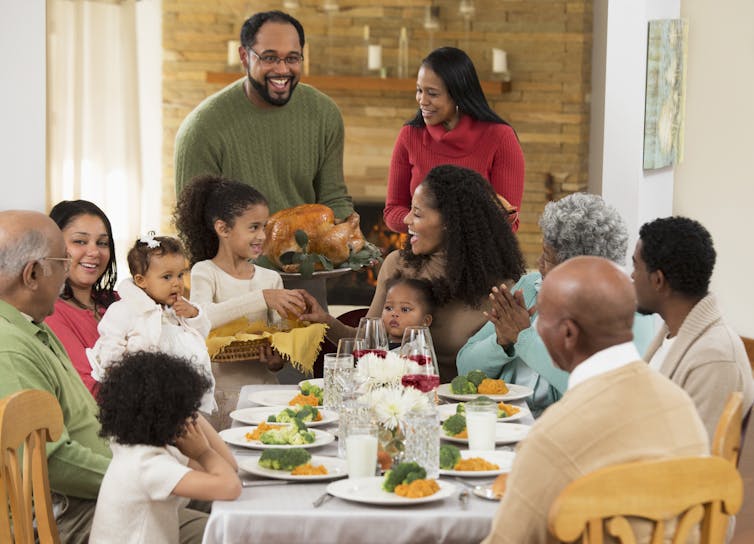As CDC warns against Thanksgiving travel, here are a dozen more things you can do to help stop COVID
Inaction over the next few months could cost tens of thousands of lives. Here are things you should do now to stay safe and to stop the spread of the coronavirus.

As Americans prepare for the first Thanksgiving in the time of the coronavirus, the Centers for Disease Control and Prevention issued a stark warning a week before the big day: Don’t travel.
No over the river and through the woods to grandmother’s condo. No flying to a beach gathering with the family you choose.
And if it sounds like the CDC is trying to be like the Grinch who stole Thanksgiving, it is important to remember the grim statistic of more than a quarter of a million people dead from COVID-19. There is no mistaking: The coronavirus is out of control.
Ultimately, lowering the staggering numbers of COVID-19 cases and deaths lies squarely with us. Yes, governments can mandate actions; but we’re the ones responsible for adhering to them. Our failure is clear when you look at the latest numbers: Deaths from the virus are projected to soon approach 2,000 Americans a day, and cases continue to climb in the vast majority of states.
If national numbers don’t spur action, will it help to localize the problem? You can find out what’s happening closer to home here at the Johns Hopkins Coronavirus Resource Center. Drill down to see the data in your state and county, then take a moment to pause and consider the catastrophic consequences. It’s still within our power to reverse course and lower these numbers. But as a public health scholar and researcher, I can tell you that as infections increase, the more difficult that becomes.
Even the rural states of North Dakota, South Dakota, Iowa and Wyoming are experiencing tremendous surges. Exhausted hospitals and health care workers across the U.S. are becoming overwhelmed, if not already there. Overwhelmed systems place care at risk. Those with other health conditions need medical intervention and hospitalization. And those with a lax attitude about COVID-19 put themselves at increased risk for negative health outcomes.

Changing behavior is a must
Modifying our behavior minimizes the chances to spread infection. But this is a big task. Government actions are most effective when based on local data and the option to loosen or tighten restrictions based on solid information. We should not view these actions as an attempt to take away our civil liberties. Instead, we should think of them as liberating, a way to keep us away from the virus.
It is not too late to modify your behavior if you’ve been reluctant to accept the realities of the virus. With promising vaccines on the horizon, our challenge as individuals is to reduce current infection numbers. And to do that, everyone must commit to established public health strategies.

A dozen things you can do
Always mask up when indoors and around people who don’t live in your household.
Always mask up when outdoors and unable to maintain physical distancing.
Use either disposable masks or a multi-layer tightly woven cotton mask. Single-layer kerchiefs are insufficient.
When you mask up, make sure it fits your face and covers both nose and mouth. Wash or sanitize your hands after touching or removing the mask.
Remember that masks are not a substitute for physical distancing.
Maintain at least six feet of distance between you and others outside of your household.
Wash your hands frequently with soap and water for 20 seconds, or use a hand sanitizer with at least 60% alcohol.
Avoid motions that transfer organisms from your hands to your face. Your mouth, nose and eyes have mucous membranes that are potentially receptive to these organisms.
Clean frequently touched surfaces.
Do as much as possible outside and keep interactions with others short.
Fortify ventilation systems for more frequent air exchanges.
Curtail in-person holiday celebrations with those not in your household.
Celebrations are particularly challenging because it’s difficult for everyone to self-quarantine for the 14 days prior to the event. Also, events are typically inside rather than out; spacing of six feet may not be an option; ventilation systems in our energy-efficient homes are likely COVID-19-insufficient; and one cannot be masked while eating.
[Deep knowledge, daily. Sign up for The Conversation’s newsletter.]
So for Thanksgiving, do a virtual gathering instead. Cook the same menu in different houses to promote a sense of sharing. Send e-cards to each other with a personal note and wish for a good holiday. Or do a Zoom call where all can speak and express thankfulness for the ability to still be able to connect this year.
It is not unusual for COVID-19 patients to rage when they discover that those around them dismissed or downplayed the wisdom and experience of scientists and doctors about the realities of the pandemic. But there is no need to give up, even in the face of increasingly frightening statistics. Instead, now is the time we need to commit not just to ourselves, but to one another. What’s standing in the way of curtailing the numbers of COVID-19 cases, hospitalizations and deaths is us.
Pamela M. Aaltonen does not work for, consult, own shares in or receive funding from any company or organization that would benefit from this article, and has disclosed no relevant affiliations beyond their academic appointment.
Read These Next
The Bible says little about Jesus’ childhood – but that didn’t stop medieval Christians from enjoyin
Legends about Jesus’ early years that circulated in medieval Europe often drew on apocryphal texts.
Sleep problems and depression can be a vicious cycle, especially during pregnancy − here’s why it’s
Inadequate sleep can have negative downstream effects on everyday cognitive functioning and mental health,…
Whether Netflix or Paramount buys Warner Bros., entertainment oligopolies are back – bigger and mor
Hollywood has seen this movie before.






